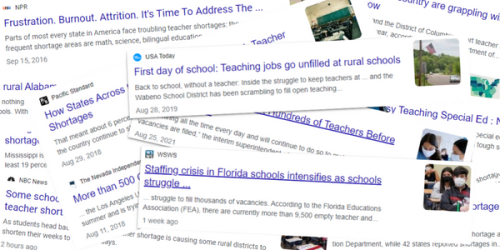Teacher shortages exist and persist in specific subjects and regions, and for some students more than others. Yet across the country, many policymakers are making decisions as though there are teacher shortages across the board. This approach will likely dilute the effect of any policy without addressing the chronically hard-to-staff schools and subjects. To ensure that all students have access to a strong, diverse teacher workforce, states need to start with an understanding of where their teachers are (and where they are not). For that, states need data.
New research from Illinois reiterates the nature of the teacher shortage problem: It is a problem of inequity. Two out of three districts have no teacher vacancies, yet students living in poverty and Black students are more likely to be in districts with higher vacancy rates.
Paul Bruno (University of Illinois at Urbana-Champaign) makes use of the state’s notably robust data system to look at unfilled positions in Illinois public schools from 2017 to 2022. This analysis finds that teacher and administrative vacancies in Illinois increased “little – if at all” after the start of the pandemic, even as more positions were created, and that there was no spike in teacher attrition during the pandemic.
Bruno finds wide variation across districts: 64% of districts reported not a single unfilled teaching position in 2022, while on the opposite end, 10% of districts reported a vacancy rate of 4.4% or more. With this data, he can also analyze trends by geography, urbanicity, and gradespan. Perhaps most interesting is his analysis looking at differences in vacancy rates experienced by students. Similar to trends found in other states, the average low-income student in the state attends a school district with a vacancy rate twice as high as that experienced by the average non-low-income student (although still relatively low at 2%); the average Black student attends a district with a vacancy rate 2.3 times higher than the districts attended by the average white student.
This data reveals wide variations in shortages by region, by district, and by student, speaking to the need for targeted policy solutions to upend these staffing inequities.
Illinois is ahead of many states in its ability to pinpoint staffing challenges and inequities. NCTQ has closely tracked state data on the teacher workforce, and a recent report revealed that many states’ data systems don’t include some important pieces of information that would help them fully assess their teacher pipeline—and whether and where it’s running dry.
More like this

How are school districts using strategic pay to attract and retain teachers where they need them?
We examine if and how 148 large U.S. school districts use strategic pay to recruit and retain teachers.

